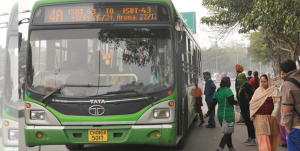 Dushyant Singh Pundir
Dushyant Singh Pundir
Chandigarh, November 4
For a smooth flow of traffic, Rail India Technical and Economic Service (RITES) Limited has suggested a reduction in the number of bus stoppages across the six busiest corridors in the tricity.
In a draft report submitted to the UT Administration on a “comprehensive mobility plan for the tricity”, RITES has identified 101-km six busiest corridors — (21 km) from ISBT-43 to New Chandigarh (Ranai Majra), (16 km) ISBT-43 to Mansa Devi Complex, (16 km) ISBT-43 to bus stand, Sector 5, Panchkula; (19 km) ISBT-17 to Kharar bus stand in Mohali, (17 km) PGI to Zirakpur bus stand, and (12 km) PGI to Panchkula bus stand.
Based on the primary surveys and data analysis, RITES, a public sector undertaking (PSU), has suggested the administration should reduce the number of bus stoppages on these six routes to decongest the traffic.
In March, the UT Administration had entrusted RITES with the task of preparing a comprehensive mobility plan for the tricity. An official said senior administrative officials and the representatives of RITES would discuss the draft report in the third week of this month and after that a final report would be prepared.
The mobility plan comprises short, medium and long-term transport improvement proposals, added the official.
In its interim report on travel characteristics at public transport terminals, RITES has studied that a maximum demand of 71,450 passengers was observed at ISBT-43 from both intra-city and inter-city travellers. Chandigarh Railway Station caters to around 40,000 daily passengers and the airport witnesses around 10,000 daily passengers.
A majority of bus and rail trips are performed for work and business purposes. A majority of air trips (35%) are carried out for tourism purpose. About 26% of bus trips are taken for educational purpose. A maximum of passengers use buses to reach the rail and bus terminals. About 87% of air passengers hire a car or a taxi to the airport. A majority (54%) of bus passengers are daily travellers while most of rail and air passengers are occasional travellers.
With regard to the share of work and educational trips in total travel demand in the tricity, RITES has identified that 16% people travel by buses, 44% by two-wheelers and cars, 10% by three-wheelers and 9% by non-motorised transport facilities. The PSU suggested that the share of public transport needed to be increased by 70 per cent.
Need to improve public transport
With regard to the share of work and educational trips in total travel demand in the tricity, Rail India Technical and Economic Service (RITES) Limited has identified that 16% people travel by buses, 44% by two-wheelers and cars, 10% by three-wheelers and 9% by non-motorised transport facilities. The company has suggested that the share of public transport needs to be increased by 70 per cent.
